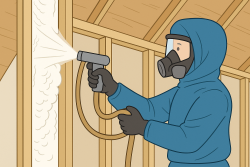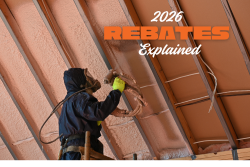The best way to keep your house cool in the summer and warm in the winter is to install an insulation system.
Proper insulation can help reduce energy loss, ensure your floors do not get cold and prevent roof ice dams. Most people forget to insulate their homes until they notice a draft or their energy bills skyrocket.
A building's insulation system works by trapping air within the insulation material. Insulation, on the other hand, is any material used to insulate buildings. A home's interior structure is covered in a blanket, which keeps treated air (cool air in the summer and hot air in the winter) inside for extended periods. By adding additional insulation, you may be able to reduce the amount of work that your heating and cooling systems need to perform to keep you comfortable in the home.
If you are doing a renovation project or want to add more insulation, you may not be sure what type is right for your home. Here are some examples of the most common insulation types used in residential homes.
Loose-fill Insulation
You may have loose-fill insulation if you see loose material in your attic or the insulation does not seem to have any tangible form. Insulation is generally blown into tight corners using specialized equipment to fill the space between joists.
There are a variety of materials you can use to make loose-fill insulation, which is commonly used in attics or hard-to-reach or seal areas. It is usually made of cellulose or fibreglass, but mineral wool is also sometimes used. It is moderately inexpensive when compared to other insulation types. If you rent the right equipment, you can do it yourself or have a professional install it.
Blanket insulation
Whether in rolls or batts, blanket insulation is a familiar type. It is typically made of fibreglass, mineral fibres, plastic, or natural fibres. It is generally installed in a home's walls, ceilings, and floors.
It is not difficult to place blanket insulation since it fits between the studs in a wall or between the joists in a floor system. The installer usually cuts the insulation to size so it fits snugly in each space.
Spray Foam Insulation or Foam Board Insulation
In homes, foam insulation comes in two forms: foam board, which is an inflexible drywall-like board placed against walls, and spray foam, which is sprayed in like loose fill.
A spray foam insulation system is a good option for hard-to-reach areas. It is sprayed around joists, where it dries quickly and hardens, making a highly protective surface. Due to its better insulation properties, it is a better choice for colder areas.
Foam board, also known as rigid foam, is commonly found on the outer walls of homes. It has several thicknesses and is a thermal, moisture, and air barrier.
Also, see this article Spray Foam Insulation Tips for Electrical Professionals.
For questions about insulation, please call Reitzel Insulation at 1-800-265-8869. We can help you determine which course of action is right for you.


















